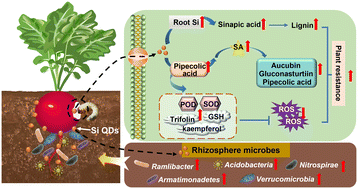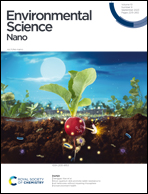Silicon quantum dots promote radish resistance to root herbivores without impairing rhizosphere microenvironment health†
Abstract
Nanotechnology employing engineered nanoparticles is currently advocated as a promising new field of interdisciplinary research for developing ecologically sound alternatives for crop protection. Silicon nanoparticles have been shown to improve plant defense against abiotic and biotic stresses. However, to date, the impact and underlying mechanism of silicon quantum dots (Si QDs), a type of silicon nanoparticles, on crop resistance against belowground insect herbivores are still unclear. Herein, we explore how Si QDs regulate radish taproot resistance against a root-chewing insect, white grub (Holotrichia oblita). We found that soil-applied 50 mg kg−1 Si QDs inhibited the growth of white grubs most (38.0%) and increased more radish taproot biomass (70.4%) than those driven by pesticides (imidacloprid) and traditional Si fertilizer (sodium silicate). Mechanistically, Si QDs increased physical resistance (Si and lignin) and chemical defense compounds (JA, SA, aucubin, gluconasturtiin and pipecolic acid), thus resulting in higher resistance to white grubs than sodium silicate. Additionally, Si QDs increased taproot antioxidant enzyme (SOD and POD) activities and antioxidant metabolite (flavonoids and glutathione) contents under white grub attack. Moreover, soil-applied Si QDs did not significantly disturb rhizosphere bacterial community diversity, but enriched several rhizosphere beneficial bacteria, such as Acidobacteria, Nitrospirae, Verrucomicrobia, Hydrogenophaga, Sphingomonas, Ramlibacter and Nitrospira. Altogether, our findings not only promote the application of Si-based nanomaterials in root pest control but also provide information on the rhizosphere environmental risk assessment of long-term exposure to nanomaterials in agroecosystems.

- This article is part of the themed collections: Environmental Science: Nano Recent HOT Articles and Nano-bio interactions


 Please wait while we load your content...
Please wait while we load your content...